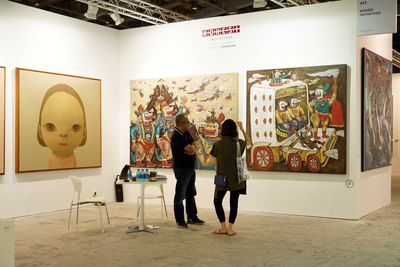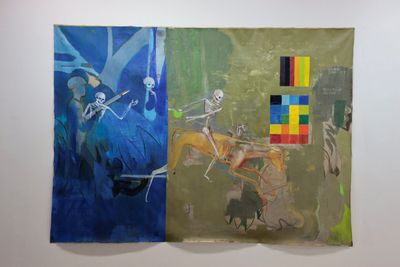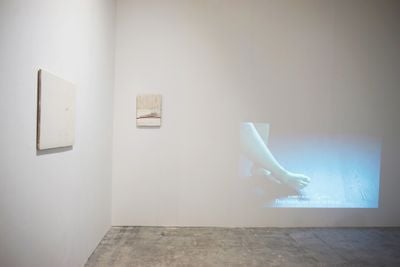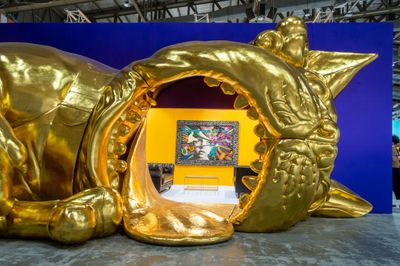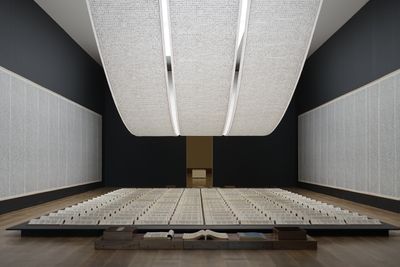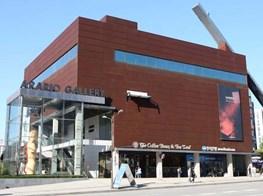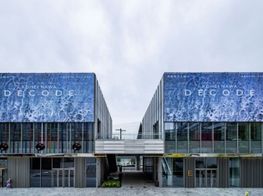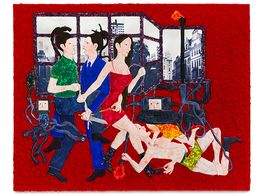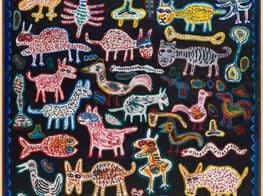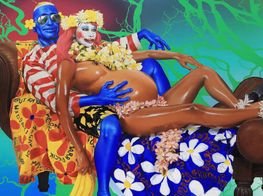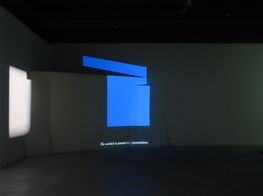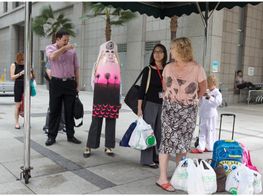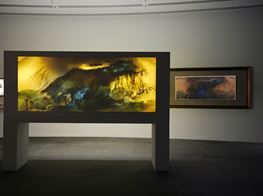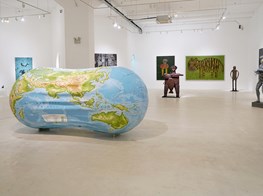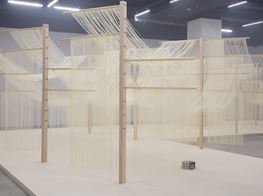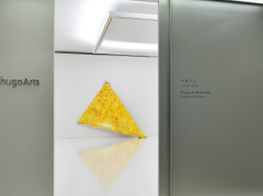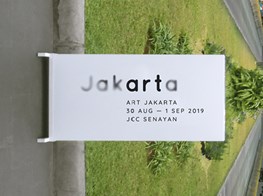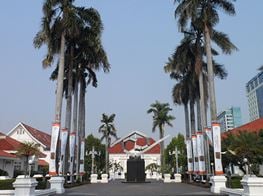Art Jakarta Drops Anchor in a Stormy Southeast Asian Art Market
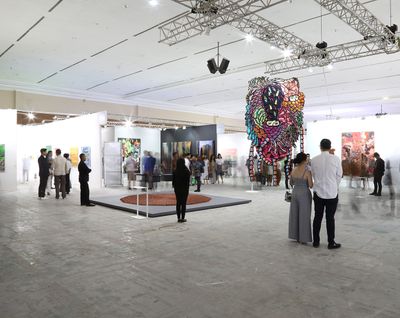
Art Jakarta (30 August–1 September 2019). Courtesy Art Jakarta.
Jakarta may be sinking, prompting the announcement last month that Indonesia will create a new capital on the island of Borneo, but the city's longest-running art fair is on the rise. Founded by the license holder of Harper's Bazaar Indonesia, the fair began as Bazaar Art Jakarta in 2008. While it's still owned by the same holding company, MRA Media Group, which owns Harper's Bazaar in Indonesia, it changed names to Art Jakarta in 2017, and received a further rebrand this year. The new logo (perhaps too cutely) adds bold to the middle syllable of Jakarta.
The 11th edition of Art Jakarta, directed by automotive executive turned art collector Tom Tandio, took place from 30 August to 1 September 2019. Seventy galleries (around 30 of them Indonesian) participated (up from 51 last year), including FOST Gallery, Mizuma Gallery, ROH Projects, and ShugoArts. The event's growth prompted a shift from the Ritz-Carlton Pacific Place to Halls A and B of the Jakarta Convention Centre, a utilitarian venue that took no attention away from the art.
For a contemporary art fair anywhere to persist into its second decade is impressive, but it's worth noting how much Art Jakarta's current form owes to the rise and fall of its regional rivals. The growth of this year's fair undoubtedly owes something to the decline of Art Stage, the brand that serial fair founder Lorenzo Rudolf established in Singapore in 2011 and brought to Jakarta in 2016 and 2017. The third edition of Art Stage Jakarta was cancelled in 2018, and in January this year, just a week before it was due to take place, Art Stage Singapore was also cancelled. Art Stage's loss has been Art Jakarta's gain, and not just in terms of gallery signups and collector attendance. Their management team also includes Art Stage alumni, with Tandio previously serving as artistic director of Art Stage and fair consultant Gil Schneider as director of exhibitor management.
In his remarks at the fair's opening, Tandio was modest, describing Art Jakarta as 'the largest and most important fair in Indonesia,' in a space that's 'on par with other international fairs'. If anything, he may be underselling Art Jakarta. With doubts over Art Stage's future, and the protests in Hong Kong diminishing the allure of fairs there, Art Jakarta only looks more enticing.
On the fair floor, Asian galleries dominated. Many made efforts to showcase artists from Indonesia and other Southeast Asian countries. Tang Contemporary, with spaces in Beijing, Hong Kong, and Bangkok, for instance, showed Entang Wiharso's The Shadow of a Flag (2017), a sci-fi-esque aluminium wall sculpture depicting a couple entwined with machinic, pipe structures; while Taipei-based TKG+ showed abstract paintings by Thai artist Mit Jai Inn and paintings by Burmese artist Sawangwongse Yawnghwe. The grandson of Burma's first president Sao Shwe Thaik, who died in prison following the 1962 military coup, Yawnghwe incorporates squares of colour inspired by military decorations in otherwise representational works such as Four Horsemen (2019), in which skeleton figures move across a barren picture plane divided into roughly painted sections of blue and green.
Singapore-based Gajah Gallery showed sumptuous paintings by Barbados-born Ashley Bickerton, who has lived in Bali for the past 26 years, among a large number of bronzes thanks to a forge Gajah Gallery owns in Yogyakarta, where it sends artists on residencies. Among these was Rooster (2019) by Indonesian artist Yunizar, a founding member of the Jendela Art Group. Another Singapore standout was Yavuz Gallery, showing works by 16 artists including Keb Cerda's Operation Wunderland (2019), a large acrylic on canvas painting of slum housing whose corrugated iron roofs radiate a pink hue, and Isabel and Alfredo Aquilizan's Left Wing Project, Wing C (2018), a large crow's wing made of hand-forged sickles overlapping like feathers.
Tokyo-based ShugoArts departed both from Southeast Asian artists and the saturated hues and reflective surfaces in many other booths to show Hong Kong artist Lee Kit. Kit's paintings and site-specific installations are often freighted with emotion, but one work in particular took on greater weight in light of the Hong Kong protests. Until it Breaks (2019) is a painting on cardboard that shows a woman at the limits of her flexibility in a full split, with the work's muted pastel colours broken by a single line of blood red.
Beyond gallery booths, Art Jakarta's curated sections included ten large-scale installations in 'Spot', featuring works by a single artist from participating galleries, and three 'AJX' collaborations between the fair and a collector or institution. These sectors were presided over by independent curator Enin Supriyanto, who was the artistic director of the Indonesian Pavilion at the 58th Venice Biennale (11 May–24 November 2019), and joined Art Jakarta as artistic director this year.
Among the highlights of AJX were six works by Nyoman Masriadi, one of Indonesia's best-selling artists, which were presented by anonymous collectors in the VIP lounge. The most arresting of these works, none of which had been shown in public before, was Deposito Emas Saya (2017), a 200 by 300 centimetre acrylic on canvas depicting a blue-black-skinned man, veins furiously straining ripped muscles, sitting on a throne of gold bars in polka dot pink underpants, a golden assault rifle in his hand. Masriadi uses these darkly complected figures to represent the common people of Indonesia, both victims and perpetrators of corruption that persists despite an ongoing crackdown by President Joko Widodo, who assumed office in 2014 and was re-elected this year.
In addition to Masriadi's paintings, an interactive LED floor that set off concentric ripples of colour around each step as audiences ascended one ramp and came down another stood out. Titled Cursory Glance, the piece was made by Isha Hening, a motion graphics artist and VJ based in Jakarta, and was presented in collaboration with the Jakarta music and arts festival Wave of Tomorrow, which was inaugurated in 2018.
Striking a more irreverent tone in the Spot section was Filipino artist Ronald Ventura's 50-square-metre man cave, Bobro's World Tour, Jakarta (2019), an art fair hideout that included not just the artist's pop art paintings but sofas, a display case full of expensive sneakers, and a karaoke booth. Presented by Yavuz Gallery, the entrance to the hideout was through the yawning maw of a giant gold Bobro, the artist's signature cartoon bulldog.
Other Spot works, dispersed throughout the fair, were likewise immersive. Yogyakarta-born Eko Nugroho's Moving Landscape (2015), presented by Arario Gallery, is a hanging piece of embroidery that used the height of the venue to its fullest, creating an imposing wall of fabric in front of the artist's sculpture Happy to be Alienated (2019), a life-sized human figure made of fibreglass painted with acrylic and adorned with embroidery. The figure, in a Ned Kelly-esque helmet with a pistol in his right hand and a steel claw in place of his left hand, seemed to confront the coral reef-like accumulations of Moving Landscape, a metaphor for the myriad metastases of urban growth.
Confrontation was also the subject of Korean artist You Ji In's mixed media installation North, K2 (2017), presented by Seoul-based The Columns Gallery, though in this instance the weapons were assault rifles made of mirrors, reminiscent of disco mirror balls. Cracked and distorted mirrors on the walls displayed North Korean propaganda slogans such as 'Wait Patiently Until the End' and 'Obey Father' in stained glass.
One of the quieter Spot works was Bandung-born artist Albert Yonathan Setyawan's Solar Worship (2015–2019), a 300-centimetre diameter terracotta tile installation presented by Singapore- and Tokyo-based Mizuma Gallery. The exquisitely crafted sculpture, laid out on the floor of the venue, depicts rays of light emanating outwards from the centre of the work, a piece that stems from his ongoing study at Kyoto Seika University, where he is completing a PhD in Indonesian contemporary ceramic art.
Despite the level of work on show at Art Jakarta, there was only a modest amount of spillover activity surrounding the fair compared to fairs in cities such as Shanghai, Hong Kong, and Singapore.
Most impressive of this activity was the private Museum MACAN's Xu Bing exhibition Thought and Method (31 August–12 January 2019). The exhibition, which first showed at Beijing's UCCA Center for Contemporary Art in July last year, included major works from key series such as Book from the Sky (1987–1991), Tobacco Project (1999–2011), Book from the Ground (2013), and Background Story (2004–ongoing). The majority of these works are on loan from Xu Bing's studio, but several also come from Indonesian collector Budi Tek's Yuz Foundation. The exhibition is well supported with wall text, imperative to the museum's espoused emphasis on education. Visitors were also offered opportunities to try their hand at writing Xu Bing's square characters—English words arranged in the square format of Chinese characters—and applying plastic bags, corn husks, and other materials to the back of a light box to create their own Background Story works.
Transition Line, the National Gallery of Indonesia's second exhibition of the national art collection, a repeat of a show first held in 2017, was less strategically timed and strangely concluded in the middle of the fair on 31 August. The museum, a colonial building with white pillars, a terracotta tile roof, and tell-tale chandeliers in the foyer, presented a competent narrative about the socio-political changes and corresponding aesthetic changes from the 1950s to the 1980s through 50 works by 40 artists including S. Sudjojono, Soedibio, and Koeboe Sarawan.
A crucial inflection point in Indonesian contemporary art history was the violent purge that followed an attempted coup in 1965, leading to the deaths of at least 500,000 communists, ethnic Chinese, and others between 1965 and 1966. That weakened Sukarno, the founding president of Indonesia, allowing General Suharto to take over and open the doors to both foreign investment and foreign cultural influence, sparking experiments with surrealism and other foreign art schools.
But a message from the gallery's director, Pustanto, in introducing the exhibition questioned the institution's ability to continue providing important historical context to today's Indonesian art. He wrote that he 'hoped that real action will be taken on efforts to save the state collection of art that need to be done immediately.'
Private museums, art fairs, and the prospect of a burgeoning art market could help establish a mandate for more public and private investment in Indonesian art. Its artists, of course, are already on board. One of the most encouraging exhibitions in Jakarta this fall was TransHuman Code, the title of the inaugural Media Art Globale festival, which had Mona Liem as artistic director, and was produced in collaboration with Ars Electronica. Running from 9 August to 1 September 2019, the exhibition showcased work by talented young Indonesian new media artists at Komunitas Salihara, the sprawling art centre established by poet and artist Goenawan Mohamad in 2010.
Highlights included Notanlab's Kokoeru (2019), a light installation that reflected the mood of Indonesians on Twitter using natural language processing software and different coloured LED lights, and Cynthia Delaney Suwito's Knitting Noodles (2019), which encouraged audiences to knit together slippery, delicate noodles, engaging slowly and mindfully with a food more associated with speed and convenience. At the end of an art fair as dynamic as Art Jakarta 2019, knitting with noodles seemed a nice change of pace.—[O]

